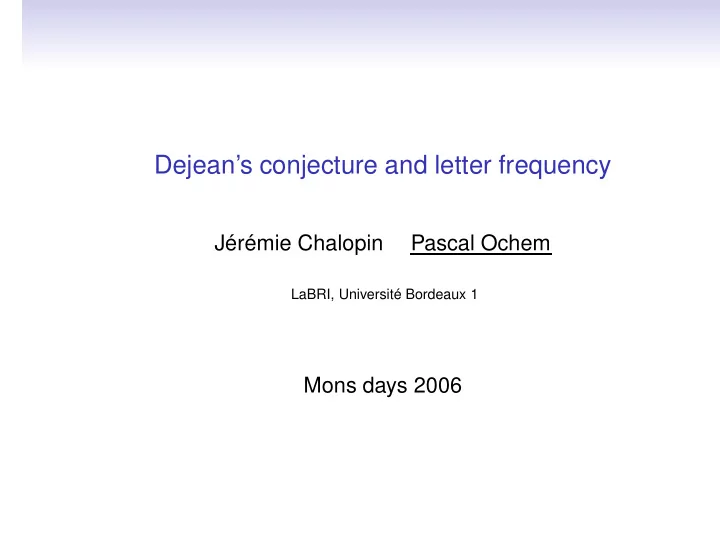

Dejean’s conjecture and letter frequency Jérémie Chalopin Pascal Ochem LaBRI, Université Bordeaux 1 Mons days 2006
Extremal letter frequencies Σ i is the i -letter alphabet { 0 , 1 ,..., i − 1 } . L is a factorial language over Σ i . Frequency of the letter 0 in w : f ( w ) = | w | 0 | w | . Extremal letter frequencies in L : • f min = lim | w |→ ∞ min { f ( w ) | w ∈ L } • f max = lim | w |→ ∞ max { f ( w ) | w ∈ L }
repetitions with fractional exponent t t n -repetition n n 0120 is a 4 3 -repetition. (prefix : 012) 0112011201 is a 5 2 -repetition. (prefix : 0112) A word is q + -free if it contains no repetition of exponent > q .
Dejean’s conjecture � + � k A k-word is an infinite -free word over Σ k . k − 1 Conjecture (Dejean 1972) For every k ≥ 5 , there exists a k-word. Proved for 5 ≤ k ≤ 14 and k ≥ 38 [Carpi 2006].
Strong forms of Dejean’s conjecture Conjecture (O. 2005) 1 (1) For every k ≥ 5 , there exists a k-word with letter frequency k + 1 . 1 (2) For every k ≥ 6 , there exists a k-word with letter frequency k − 1 . For 5-words, f max < 103 440 = 0 . 23409 ··· < 1 4 .
Our results Theorem (Chalopin, O. 2005) (1) There exists a 5-word with letter frequency 1 6 . (2) There exists a 6-word with letter frequency 1 5 .
Form of k -words with extremal letter frequency In both cases, 0’s must be regularly spaced : 1 (1) f min = k + 1 : ······ 0 α 1 ··· α k − 1 α 1 0 β 1 ··· β k − 1 β 1 0 γ 1 ··· γ k − 1 γ 1 0 ······ 1 (2) f max = k − 1 : ······ 0 δ 1 ··· δ k − 2 0 σ 1 ··· σ k − 2 0 ω 1 ··· ω k − 2 0 ······ Where α , β , γ , δ , σ , ω are permutations of [ 1 , 2 ,..., k − 1 ] . NB : For k -words with f = 1 k , 0’s cannot be regularly spaced : 0 , 1 , 2 ,..., k − 1 , 0 , 2 , 1 ,..., 0 , 1 , 2 ⇒ it is a repetition of exponent 2 k + 3 k = k − 1 . > 2 k
Minimal letter frequency 5-words with letter frequency 1 6 . Two possible transitions : • 012341024312 correspond to the transition permutation 2431 (noted 0). • 012341032143 correspond to the transition permutation 3214 (noted 1). Example : 01001 is coding the word 012341024312034213041234013241023142. = ⇒ It remains to construct an infinite binary code.
Minimal letter frequency One infinite binary code is the fixed point h ω ( 0 ) of the following morphism h . h ( 0 ) = 010010010100101001001001010100101001001001010010101001001001010 h ( 1 ) = 100101001001010100101001001010100101001001001010010010010100101 Useful properties of h : (1) uniform : | h ( 0 ) | = | h ( 1 ) | = 63. (2) synchronizing : ∀ a , b , c ∈ Σ 2 , ∀ s , r ∈ Σ ∗ 2 , if h ( ab ) = rh ( c ) s , then either r = ε and a = c or s = ε and b = c . (3) ∀ i ∈ Σ 2 , h ( i ) = iwi . (4) ∀ i ∈ Σ 2 , h ( i ) is the same transition as i .
Maximal letter frequency 6-words with letter frequency 1 5 . Two possible transitions : • 0123405132 correspond to the transition permutation 51324 (noted 0). • 0123405213 correspond to the transition permutation 52134 (noted 1). One infinite binary code is the fixed point h ω ( 0 ) of the following 25-uniform morphism m . m ( 0 ) = 0010010100111000110100010 m ( 1 ) = 1000100111000100110100011
Conclusion • interest : avoiding repetition & some regularity. • Other cases are harder : For 6-words with letter frequency 1 7 . Three possible transitions, and no infinite code using only two of these three transitions.
Recommend
More recommend